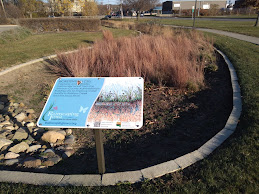 |
| Our Iowa River, with stormwater outlets |
Saturday, October 29, 2022
A Clean Water Act for the 21st Century?
Saturday, October 15, 2022
New Neighbors in the South District
The city has been planting trees in the right-of-way (the space between the sidewalk and the curb) along those two streets and surrounding neighborhoods, with nearly 100 trees in a variety of species that will create a rich, diverse canopy to shade the community for decades to come.
The project is aligned with the Parks Department's goal of increasing our tree canopy coverage in order to develop and enhance our parks and open spaces, with one measurable objective being increasing the number of trees planted in the city right-of-way. Last year over 1000 trees were estimated to have been planted in right-of-ways, and this year another 750 are estimated to be planted.

The city Climate Action & Outreach service is also again offering the Root for Trees program, which gives residents a 50% discount on trees to be planted on properties in the city, so if you are not one of the lucky homes receiving a right-of-way tree, you can purchase a tree yourself at a deep discount.
Trees provide services to neighborhoods by shading our houses from the hot sun in the summer, and screening us from strong winds with the branches. Their strong roots stabilize the soil and prevent runoff, and they provide habitat and sanctuary for the birds and other wildlife that enhance our lives in so many ways.
**Be sure to water young trees their first couple of years as they get established! The city will care for the trees they have planted, but it can be difficult to keep up with so many trees when nature doesn't always cooperate with regular, refreshing rains. I suspect the city wouldn't be offended if you offered a newly-planted sapling in your area a little extra drink every once in a while.
Sunday, October 2, 2022
Marvelous Trees
Trees capture the human imagination in a way other plants rarely can. Their stature, as they stand year-round in our landscapes while forbs die away each winter. Their longevity, living for many more decades, even centuries, than we do.
Our early myths tell tree spirits like dryads, or of sacred trees with roots stretching below and branches stretching above in a mirror image. We don't generally imagine nymphs inhabiting coneflowers, or a holy fungus connecting the world via filaments. It is the noble tree that is woven through our histories and our mythologies, from George Washington's cherry tree to John Muir's towering sequoias, to our lists of "champion trees" across the country and Iowa's own "Big Tree Program" with a list of our state's most spectacular specimens.
Communities develop relationships with unique trees, like the larch that used to grace the Pentacrest, or the big catalpa on Summit Street (both, sadly, lost in recent years: the larch to a storm in 2019, and the catalpa to the 2020 derecho, along with thousands of its comrades across the state).
Throughout my life I've developed one-sided friendships with many trees, and recall several fondly. There was George, just an average honey locust in a park by the railroad tracks, who served as the subject of a "tree diary" assignment in a high school biology class. The tiny tulip tree sapling whose owner, Mr. Stan, kindly allowed me to snip a couple of its very few leaves for that same biology class.
Recently and locally, there is the one remaining sweet gum tree west of the Old Capitol parking ramp, its skinny frame once flanked by others before they had to make way for a new building. I try to say hello whenever I drive past. (My affection for specific trees is related to how easy they are to identify; the star-shaped leaves and spiky seedballs of sweet gum making it one of the easier species for me).
And my two favorites, the pair of bald cypresses along the trail on Highway 6, near Hills Bank and the river. Taxodium distichum is one of my favorite trees, a gymnosperm with soft, flattened needles and a fibrous-looking bark. In the winter they drop their leaves--an unusual trait for a conifer, with most being known broadly as "evergreens" due to their winter greenery. Their native range doesn't reach Iowa, instead extending through states around the lower Mississippi, around the Gulf coast and southern coastal states.
There aren't any bald cypress trees along the Greenway, and they aren't terribly common in town: the city's tree inventory shows only 38 on city land (for comparison, there are over 1000 honey locusts, nearly 3000 oaks and more than twice that many maples). There are very few conifers at all along the Greenway, besides some scattered weedy red cedars and the line of white pines near the Sycamore Apartments.
I would often stop to caress the feathery leaves and touch the bark of my bald cypress friends, marveling at the clever "cones"--textured spheres that change from green to brown as they age--and admire their fine spreading branches and forms, the westerly tree a bit wider but both very elegant as their lowest branches nearly sweep the ground.
Last week on a drive past my pals I looked over and gasped. Their beautiful spreading branches had been lopped several feet up from the ground, revealing trim, naked trunks. It was a small shock, like seeing a friend whose long hair you've admired walk up with a jaunty bob, or a modest dresser swapping long pants for hot pants.
"It's...nice. You're gorgeous however you style your branches, and I bet this is so much easier to manage" while silently contemplating how much better you thought they looked before. It's one of the hazards of befriending trees you don't own: no one consults you before performing routine maintenance on them.
But they're fine. They're healthy, and being cared for, and I'm happy that I still get to visit with them, even if their branches not as easy to reach for a gentle greeting. I hope to visit with them for decades to come.









